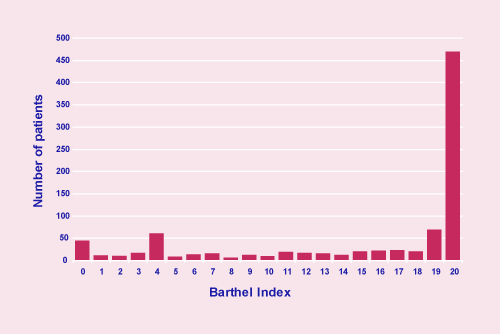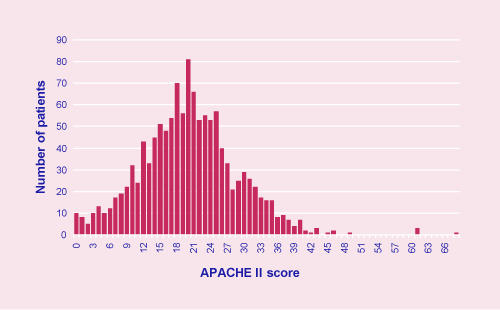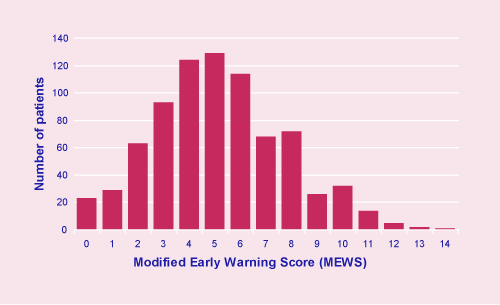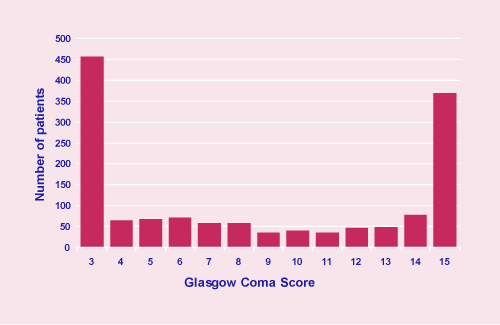Report >> |
3. Data overview
| Introduction |
| Hospital participation |
| Clinical questionnaires |
| Organisational questionnaire |
| Age and sex |
| Admission method to hospital |
| Source of admission to the ICU |
| Severity of the patient’s condition |
Severity of the patient's condition
The Barthel Index 13, the APACHE II score 14, the Modified Early Warning Score 15 and the Glasgow Coma Score 16 were all requested as a means to assess the severity of the patient’s condition. The data provided on these parameters were reviewed with some caution for two main reasons:
- The high number of accident and emergency admissions meant that an accurate understanding of the patient condition prior to hospital admission was unknown. For example, many patients would have had a low Barthel Index on arrival at hospital but may have scored much higher a matter of hours earlier. Similarly, it was not always possible to calculate the Modified Early Warning Score.
- As there were no time intervals stated in the questions relating to the APACHE II score and the Glasgow Coma Score, it was difficult to interpret these data clearly. In both cases the clinician was asked for their first score on admission to ICU but this may have been at one hour or 24 hours and there was no consistency to when it would have first been recorded.
Where the scores had not been provided but enough clinical factors were available to calculate the score, this was done by NCEPOD. Charted below are the findings from the four scores where the score was available.
The Barthel Index is an assessment of the ability of individuals to perform activities of daily living 13. The maximum score, indicating a fully active and independent person, is 20. There were 73% (905/1,235) of cases where the Barthel Index had been completed in full on the physician questionnaire, 15% (183/1,235) of cases where it was incomplete and 12% (147/1,235) of cases where the question was not answered. Figure 6 shows the distribution of scores by number of patients for those that were completed in full.

Figure 6. Barthel Index n=1,235
The APACHE II score is a severity of illness score that measures the degree of acute physiological impairment, but also takes into account age and chronic health problems 14. The APACHE II score was provided, or calculated from the physiological variables provided on the intensive care questionnaire, in 78% (1,241/1,596) of cases. The physiological variables were incomplete in 22% (354/1,596) cases and absent in one. Figure 7 shows the distribution of scores by number of patients for those that were completed in full.

Figure 7. APACHE II score n=1,596
There were 64% (795/1,235) of cases where the Modified Early Warning Score 15 had been completed
in full on the physician questionnaire, 22% (275/1,235) of cases where it was incomplete and 13% (165/1,235) of cases where the question was not answered. Figure 8 shows the distribution of scores
by number of patients for those that were completed in full.

Figure 8. Modified Early Warning Score n=1,235
The Glasgow Coma Score 16 was provided in 90% (1,431/1,596) of cases on the intensive care questionnaire. The score was incomplete in three cases and not answered in 162 cases. Figure 9 shows the distribution of scores by number of patients for those that were completed in full. The unusual distribution of Glasgow Coma Score is probably a reflection that many sedated patients were incorrectly assigned to a Glasgow Coma Score of three, rather than the pre-sedation Glasgow Coma Score, as it is unlikely that such a high number of patients actually had such a low coma score.

Figure 9. Glasgow Coma Score n=1,596
As the data were available for most, though not all, patients for each score, it is believed that the sample presented is representative of the population.